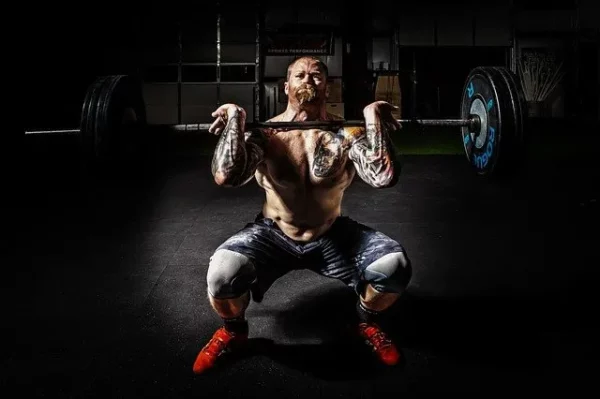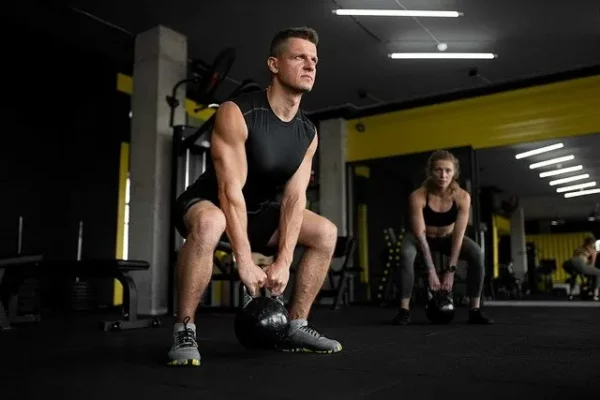In This Article
Knee pain after squats has to be one of the most common complaints after a gym session! It’s NOT a sign that squats are bad for you… It’s probably a sign you need to work on your squats to get the most out of them.
If you’re experiencing knee pain after squats, there are three likely scenarios causing your pain:
- Abnormal loading patterns during the squat
- Excessive loading relative to the knee’s capacity
- Loading sensitive and/or injured structures
Let’s cover each of these issues and how you can remedy them (hint: stopping squats isn’t the solution!)

Causes of knee pain after squats
Abnormal loading patterns
Abnormal loading patterns describes any movement that changes the direction of pressure or amount of pressure on the knee in a way that isn’t normal for that knee. It’s important to highlight that we’re saying for “that” knee, because every knee is different and your ideal might be different from someone else’s ideal pattern.
It can be due to:
- poor technique due to fatigue, restricted joint range or lack of competence
- other injuries or soreness, causing a compensation in the squat movement
- occasionally it can be from equipment issues (eg. shoes, surface)
Poor or fatigued technique often results in a change in load distribution during the squat. As your back fatigues, you might position your trunk more upright and bend your knees more. That causes an emphasis on knee loading or an inwards movements of the knee, leading to knee pain after squats.
These abnormal patterns increase the force on specific areas of cartilage within the knee, causing them to become sensitive and painful with repeated exposures.
You can typically identify if the underlying issue is fatigue, range of motion or competence by observing when the technique starts to degrade. If the squat technique starts good and falls apart late in the set, it’s muscle fatigue. If it starts poor and improves with reps, it’s probably joint restriction (which loosens up with reps). If it starts bad and stays bad…how to put this delicately….your skill level may be the culprit!
Excessive loading
Excessive loading isn’t lifting heavier weights, otherwise no-one would ever need those 25kg plates! It’s about lifting more than your knee can currently support.
During a squat within your current capacity, your muscles generate leverage across joints with smooth controlled movements.
As you gradually increase the weight, you get a small amount of muscle or joint soreness after the squat.
The mild inflammatory response in muscles, bones and joints triggers a rebuilding phase. As the knee increases its structural capacity, that inflammatory response and soreness will disappear.
If the increase in weight is too big of a jump though, the muscles and joints are pushed well beyond their current tolerance without having time to respond and strengthen.
This results in knee pain after squats as the reaction produces larger amounts of inflammation.
Unfortunately this large reaction doesn’t produce a rebuilding effect like the milder reaction. Often the body struggles to recover and begins to gradually breakdown.
The big point to remember is that gains aren’t going to happen on a schedule or in distinct increments. You can’t just add 5kg to your squat each month and expect the body to continually respond.
Loading sensitive and/or injured tissue
You might still get knee pain after squats, even with loading within your current tolerance and good movement patterns. In this situation, the culprit maybe the cartilage itself.
There are various reasons why cartilage can become thin, worn or damaged over time.
This ISN’T due to consistent strength training over long periods. I’m sure you’ve heard someone say that squats are wearing away your knees – WRONG!
The real reason is usually related to large amounts of variability in load. Hitting the gym hard for 3 months…followed by 2 months of inactivity…then a month of making up for lost time… You get the idea.
Once the cartilage itself has reduced or lost its capacity, seemingly normal loads will cause a disproportionate reaction.
You’ll still benefit from loading the area – avoiding squats is not a solution.
But it may require an easier starting point and more gradual increments in loading the injured area. Or you may need to modify the squat technique to reduce knee loading, usually by moving the weight further forward from your centre of balance.

If you think you’re in this situation, the first step is to confirm the diagnosis. Then you’ll need the input of a health professional to help advise and control your gym program.
Remember that avoiding squats isn’t a solution but neither is letting denial and frustration plan your workout.
